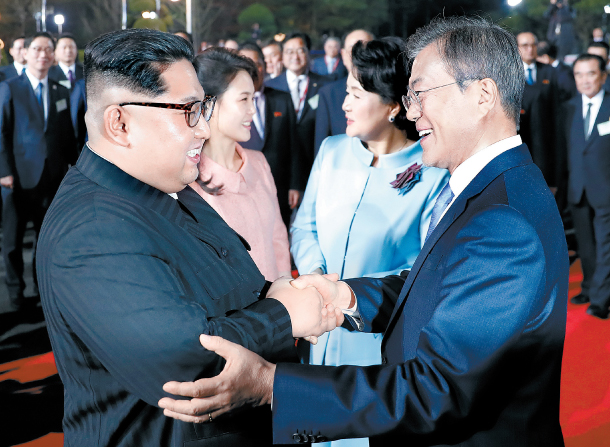Panmunjom on my mind
YANG SUNG-HEE*The author is an editorial writer at the JoongAng Ilbo.

[JOINT PRESS CORPS]
That summer, two U.S. Army officers were cutting down a poplar tree in the Joint Security Area when North Korean guards killed them with an ax. As an elementary school student, I was scared. The ax-wielding North Korean soldiers matched the image of an evil North Korea, an image that dominated my childhood.
Later in 1989, I remember seeing Lim Su-kyung, a South Korean activist, return through Panmunjom after attending the World Festival of Youth and Students in Pyongyang, representing a leftist student organization.
Lim was arrested upon crossing the military demarcation line, but then in 1998, Hyundai Group Chairman Chung Ju-yung led 1001 cows over the same line through Panmunjom. The 83-year-old chairman, who had left his hometown in North Korea, returned with a herd of cattle as a successful capitalist. The French critic Guy Sorman called it “the last avant-garde art of the 20th century.”
Writer Lee Ho-chul, a refugee from North Korea, became a central figure in post-Korean War literature with his 1961 short story “Panmunjom.” It is an autobiographical piece about the painful reality of division, the story of a short meeting between a South Korean man and North Korean reporter at Panmunjom. In 2012, he published a sequel titled “Panmunjom II.”
Park Chan-wook took a more humanizing approach toward North Korean soldiers with his 2000 film “Joint Security Area.” Over five million moviegoers were moved to tears by the scene of South and North Korean soldiers sharing a chocolate cake as Kim Kwang-seok’s “Letter of a Private” was playing the background. The movie was a blockbuster hit and broke South Koreans’ long-rooted “red scare” complex. It is no coincidence that the cheering squad for the South Korean team at the 2002 World Cup hosted by South Korea and Japan was called the Red Devils. Later, at the Venice Architecture Biennale in 2016, the artist Choi Jae-eun proposed building a floating garden over the demilitarized zone.
Now, after April 27, Panmunjom will be newly remembered in the minds of South Koreans. The world watched as the leaders of both Koreas held hands and crossed the military demarcation line. It is surreal and dramatic because not so long ago, a North Korean soldier risked his life to defect across the demilitarized zone as his compatriots fired at him.
Of course, there is a long way to go. It would be naïve to expect immediate and complete denuclearization and peace. However, we have surely seen the most dramatic and hopeful moment of Panmunjom, which has so long been a symbol of division.
JoongAng Sunday, April 28-29, Page 34










with the Korea JoongAng Daily
To write comments, please log in to one of the accounts.
Standards Board Policy (0/250자)